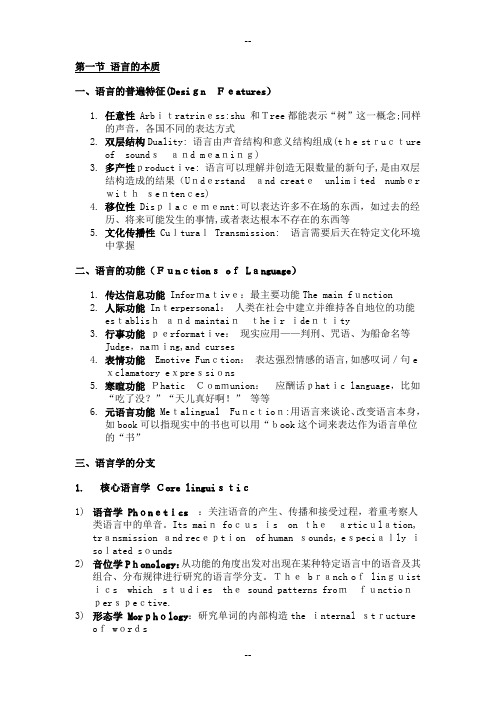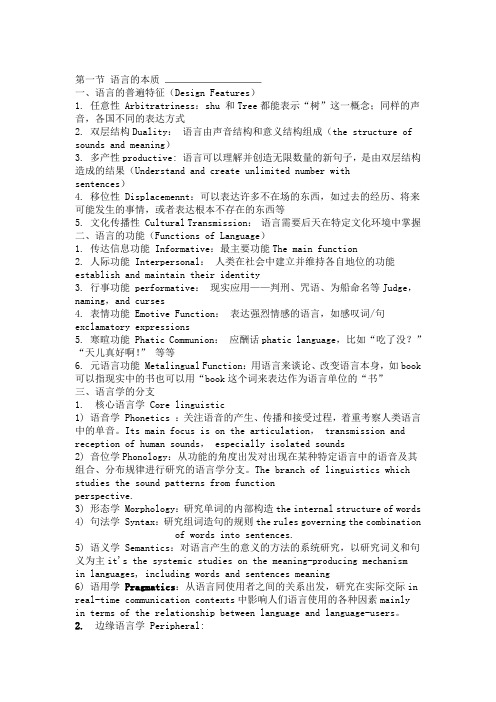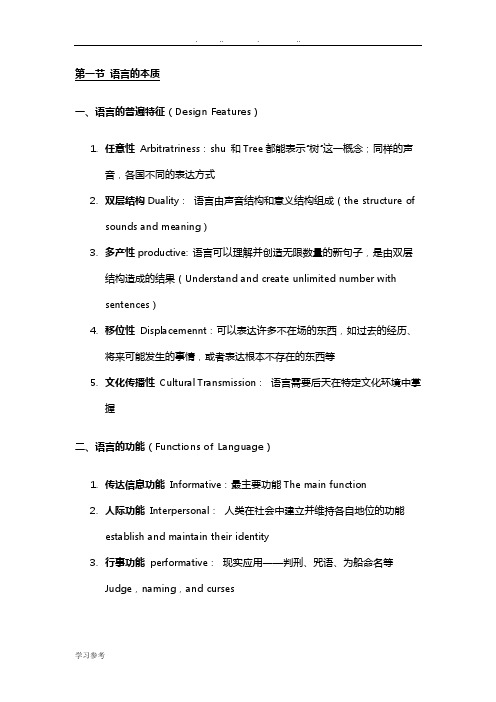中英文对照--英语语言学重要概念解析--英语专业学生-教师资格证考生
语言学重要概念梳理(中英文对照版)

第一节语言的本质一、语言的普遍特征(Design Features)1.任意性 Arbitratriness:shu 和Tree都能表示“树”这一概念;同样的声音,各国不同的表达方式2.双层结构Duality:语言由声音结构和意义结构组成(the structure ofsounds and meaning)3.多产性productive:语言可以理解并创造无限数量的新句子,是由双层结构造成的结果(Understand and create unlimited number withsentences)4.移位性 Displacemennt:可以表达许多不在场的东西,如过去的经历、将来可能发生的事情,或者表达根本不存在的东西等5.文化传播性 Cultural Transmission:语言需要后天在特定文化环境中掌握二、语言的功能(Functions of Language)1.传达信息功能 Informative:最主要功能The main function2.人际功能 Interpersonal:人类在社会中建立并维持各自地位的功能establish and maintain their identity3.行事功能 performative:现实应用——判刑、咒语、为船命名等Judge,naming,and curses4.表情功能 Emotive Function:表达强烈情感的语言,如感叹词/句exclamatory expressions5.寒暄功能 Phatic Communion: 应酬话phatic language,比如“吃了没?"“天儿真好啊!”等等6.元语言功能 Metalingual Function:用语言来谈论、改变语言本身,如book可以指现实中的书也可以用“book这个词来表达作为语言单位的“书”三、语言学的分支1. 核心语言学 Core linguistic1)语音学 Phonetics:关注语音的产生、传播和接受过程,着重考察人类语言中的单音.Its main focus is on the articulation, transmission and reception of human sounds, especially isolated sounds2)音位学Phonology:从功能的角度出发对出现在某种特定语言中的语音及其组合、分布规律进行研究的语言学分支。
语言学重要概念梳理(中英文对照版)

第一节语言的本质一、语言的普遍特征(Design Features)1.任意性 Arbitratriness:shu 和Tree都能表示“树”这一概念;同样的声音,各国不同的表达方式2.双层结构Duality:语言由声音结构和意义结构组成(the structure ofsounds and meaning)3.多产性productive: 语言可以理解并创造无限数量的新句子,是由双层结构造成的结果(Understand and create unlimited number withsentences)4.移位性 Displacemennt:可以表达许多不在场的东西,如过去的经历、将来可能发生的事情,或者表达根本不存在的东西等5.文化传播性 Cultural Transmission:语言需要后天在特定文化环境中掌握二、语言的功能(Functions of Language)1.传达信息功能 Informative:最主要功能The main function2.人际功能 Interpersonal:人类在社会中建立并维持各自地位的功能establish and maintain their identity3.行事功能 performative:现实应用——判刑、咒语、为船命名等Judge,naming,and curses4.表情功能 Emotive Function:表达强烈情感的语言,如感叹词/句exclamatory expressions5.寒暄功能 Phatic Communion:应酬话phatic language,比如“吃了没?”“天儿真好啊!”等等6.元语言功能 Metalingual Function:用语言来谈论、改变语言本身,如book可以指现实中的书也可以用“book这个词来表达作为语言单位的“书”三、语言学的分支1. 核心语言学 Core linguistic1)语音学 Phonetics:关注语音的产生、传播和接受过程,着重考察人类语言中的单音。
语言学重要概念梳理(中英文对照版)

第一节语言的本质一、语言的普遍特征(Design Features)1.任意性 Arbitratriness:shu 和Tree都能表示“树”这一概念;同样的声音,各国不同的表达方式2.双层结构Duality: 语言由声音结构和意义结构组成(the structureof soundsand meaning)3.多产性productive: 语言可以理解并创造无限数量的新句子,是由双层结构造成的结果(Understand and createunlimited number withsentences)4.移位性 Displacemennt:可以表达许多不在场的东西,如过去的经历、将来可能发生的事情,或者表达根本不存在的东西等5.文化传播性 Cultural Transmission: 语言需要后天在特定文化环境中掌握二、语言的功能(Functions of Language)1.传达信息功能 Informative:最主要功能The main function2.人际功能 Interpersonal:人类在社会中建立并维持各自地位的功能establishand maintaintheir identity3.行事功能performative:现实应用——判刑、咒语、为船命名等Judge,naming,and curses4.表情功能Emotive Function:表达强烈情感的语言,如感叹词/句exclamatory expressions5.寒暄功能Phatic Communion:应酬话phatic language,比如“吃了没?”“天儿真好啊!”等等6.元语言功能 Metalingual Function:用语言来谈论、改变语言本身,如book可以指现实中的书也可以用“book这个词来表达作为语言单位的“书”三、语言学的分支1. 核心语言学Core linguistic1)语音学 Phonetics:关注语音的产生、传播和接受过程,着重考察人类语言中的单音。
语言学重要概念梳理中英文对照版

第一节语言的本质一、语言的普遍特征(Design Features)1.任意性 Arbitratriness:shu 和Tree都能表示“树”这一概念;同样的声音,各国不同的表达方式2.双层结构Duality:语言由声音结构和意义结构组成(the structure of sounds and meaning)3.多产性productive: 语言可以理解并创造无限数量的新句子,是由双层结构造成的结果(Understand and create unlimited number withsentences)4.移位性 Displacemennt:可以表达许多不在场的东西,如过去的经历、将来可能发生的事情,或者表达根本不存在的东西等5.文化传播性 Cultural Transmission:语言需要后天在特定文化环境中掌握二、语言的功能(Functions of Language)1.传达信息功能 Informative:最主要功能The main function2.人际功能 Interpersonal:人类在社会中建立并维持各自地位的功能establish and maintain their identity3.行事功能 performative:现实应用——判刑、咒语、为船命名等Judge,naming,and curses4.表情功能 Emotive Function:表达强烈情感的语言,如感叹词/句exclamatory expressions5.寒暄功能 Phatic Communion:应酬话phatic language,比如“吃了没?”“天儿真好啊!”等等6.元语言功能 Metalingual Function:用语言来谈论、改变语言本身,如book 可以指现实中的书也可以用“book这个词来表达作为语言单位的“书”三、语言学的分支1. 核心语言学 Core linguistic1)语音学 Phonetics :关注语音的产生、传播和接受过程,着重考察人类语言中的单音。
语言学重要概念梳理(中英文对照版)

语⾔学重要概念梳理(中英⽂对照版)第⼀节语⾔的本质⼀、语⾔的普遍特征(Design Features)1.任意性 Arbitratriness:shu 和Tree都能表⽰“树”这⼀概念;同样的声⾳,各国不同的表达⽅式2.双层结构Duality:语⾔由声⾳结构和意义结构组成(the structure ofsounds and meaning)3.多产性productive: 语⾔可以理解并创造⽆限数量的新句⼦,是由双层结构造成的结果(Understand and create unlimited number withsentences)4.移位性 Displacemennt:可以表达许多不在场的东西,如过去的经历、将来可能发⽣的事情,或者表达根本不存在的东西等5.⽂化传播性 Cultural Transmission:语⾔需要后天在特定⽂化环境中掌握⼆、语⾔的功能(Functions of Language)1.传达信息功能 Informative:最主要功能The main function2.⼈际功能 Interpersonal:⼈类在社会中建⽴并维持各⾃地位的功能establish and maintain their identity3.⾏事功能 performative:现实应⽤——判刑、咒语、为船命名等Judge,naming,and curses4.表情功能 Emotive Function:表达强烈情感的语⾔,如感叹词/句exclamatory expressions5.寒暄功能 Phatic Communion:应酬话phatic language,⽐如“吃了没?”“天⼉真好啊!”等等6.元语⾔功能 Metalingual Function:⽤语⾔来谈论、改变语⾔本⾝,如book可以指现实中的书也可以⽤“book这个词来表达作为语⾔单位的“书”三、语⾔学的分⽀1. 核⼼语⾔学 Core linguistic1)语⾳学 Phonetics:关注语⾳的产⽣、传播和接受过程,着重考察⼈类语⾔中的单⾳。
中英文对照英语语言学重要概念解析英语专业学生教师资格证考生

第一节语言的本质一、语言的普遍特征(Design Features)任意性Arbitratriness:shu 和Tree都能表示“树”这一概念;同样的声音,各国不同的表达方式双层结构Duality:语言由声音结构和意义结构组成(the structure of sounds and meaning)多产性productive: 语言可以理解并创造无限数量的新句子,是由双层结构造成的结果(Understand and create unlimited number with sentences)移位性Displacemennt:可以表达许多不在场的东西,如过去的经历、将来可能发生的事情,或者表达根本不存在的东西等文化传播性Cultural Transmission:语言需要后天在特定文化环境中掌握二、语言的功能(Functions of Language)1. 传达信息功能Informative:最主要功能The main function2. 人际功能Interpersonal:人类在社会中建立并维持各自地位的功能establish and maintain their identity3. 行事功能performative:现实应用——判刑、咒语、为船命名等Judge,naming,and curses4. 表情功能Emotive:表达强烈情感的语言,如感叹词/句exclamatory expressions5. 寒暄功能Phatic:应酬话phatic language,比如“吃了没?”“天儿真好啊!”等等6. 元语言功能Metalingual:用语言来谈论、改变语言本身,如book可以指现实中的书也可以用“book这个词来表达作为语言单位的“书”三、语言学的分支1. 核心语言学Core linguisticl 语音学Phonetics :关注语音的产生、传播和接受过程,着重考察人类语言中的单音。
语言学重要概念梳理(中英文对照版)

第一节语言的本质一、语言的普遍特征(Design Features)1.任意性 Arbitratriness:shu 和Tree都能表示“树”这一概念;同样的声音,各国不同的表达方式2.双层结构Duality:语言由声音结构和意义结构组成(the structure ofsounds and meaning)3.多产性productive: 语言可以理解并创造无限数量的新句子,是由双层结构造成的结果(Understand and create unlimited number withsentences)4.移位性 Displacemennt:可以表达许多不在场的东西,如过去的经历、将来可能发生的事情,或者表达根本不存在的东西等5.文化传播性 Cultural Transmission:语言需要后天在特定文化环境中掌握二、语言的功能(Functions of Language)1.传达信息功能 Informative:最主要功能The main function2.人际功能 Interpersonal:人类在社会中建立并维持各自地位的功能establish and maintain their identity3.行事功能 performative:现实应用——判刑、咒语、为船命名等Judge,naming,and curses4.表情功能 Emotive Function:表达强烈情感的语言,如感叹词/句exclamatory expressions5.寒暄功能 Phatic Communion:应酬话phatic language,比如“吃了没?”“天儿真好啊!”等等6.元语言功能 Metalingual Function:用语言来谈论、改变语言本身,如book可以指现实中的书也可以用“book这个词来表达作为语言单位的“书”三、语言学的分支1. 核心语言学 Core linguistic1)语音学 Phonetics:关注语音的产生、传播和接受过程,着重考察人类语言中的单音。
语言学重要概念梳理中英文对照版

第一节语言的本质一、语言的普遍特征(Design Features)1.任意性Arbitratriness:shu 和Tree都能表示“树”这一概念;同样的声音,各国不同的表达方式2.双层结构Duality:语言由声音结构和意义结构组成(the structure ofsounds and meaning)3.多产性productive: 语言可以理解并创造无限数量的新句子,是由双层结构造成的结果(Understand and create unlimited number withsentences)4.移位性Displacemennt:可以表达许多不在场的东西,如过去的经历、将来可能发生的事情,或者表达根本不存在的东西等5.文化传播性Cultural Transmission:语言需要后天在特定文化环境中掌握二、语言的功能(Functions of Language)1.传达信息功能Informative:最主要功能The main function2.人际功能Interpersonal:人类在社会中建立并维持各自地位的功能establish and maintain their identity3.行事功能performative:现实应用——判刑、咒语、为船命名等Judge,naming,and curses4.表情功能Emotive Function:表达强烈情感的语言,如感叹词/句exclamatory expressions5.寒暄功能Phatic munion:应酬话phatic language,比如“吃了没?”“天儿真好啊!”等等6.元语言功能Metalingual Function:用语言来谈论、改变语言本身,如book可以指现实中的书也可以用“book这个词来表达作为语言单位的“书”三、语言学的分支1. 核心语言学Core linguistic1)语音学Phonetics:关注语音的产生、传播和接受过程,着重考察人类语言中的单音。
中英文对照 英语语言学重要概念解析 英语专业学生 教师资格证考生.精讲

第一节语言的本质一、语言的普遍特征(Design Features)任意性Arbitratriness:shu 和Tree都能表示“树”这一概念;同样的声音,各国不同的表达方式双层结构Duality:语言由声音结构和意义结构组成(the structure of sounds and meaning)多产性productive: 语言可以理解并创造无限数量的新句子,是由双层结构造成的结果(Understand and create unlimited number with sentences)移位性Displacemennt:可以表达许多不在场的东西,如过去的经历、将来可能发生的事情,或者表达根本不存在的东西等文化传播性Cultural Transmission:语言需要后天在特定文化环境中掌握二、语言的功能(Functions of Language)1. 传达信息功能Informative:最主要功能The main function2. 人际功能Interpersonal:人类在社会中建立并维持各自地位的功能establish and maintain their identity3. 行事功能performative:现实应用——判刑、咒语、为船命名等Judge,naming,and curses4. 表情功能Emotive:表达强烈情感的语言,如感叹词/句exclamatory expressions5. 寒暄功能Phatic:应酬话phatic language,比如“吃了没?”“天儿真好啊!”等等6. 元语言功能Metalingual:用语言来谈论、改变语言本身,如book可以指现实中的书也可以用“book这个词来表达作为语言单位的“书”三、语言学的分支1. 核心语言学Core linguisticl 语音学Phonetics :关注语音的产生、传播和接受过程,着重考察人类语言中的单音。
语言学重要概念梳理(中英文对照版)

第一节语言的本质一、语言的普遍特征(Design Features)1.任意性 Arbitratriness:shu 和Tree都能表示“树”这一概念;同样的声音,各国不同的表达方式2.双层结构Duality:语言由声音结构和意义结构组成(the structure ofsounds and meaning)3.多产性productive: 语言可以理解并创造无限数量的新句子,是由双层结构造成的结果(Understand and create unlimited number withsentences)4.移位性 Displacemennt:可以表达许多不在场的东西,如过去的经历、将来可能发生的事情,或者表达根本不存在的东西等5.文化传播性 Cultural Transmission: 语言需要后天在特定文化环境中掌握二、语言的功能(Functions of Language)1.传达信息功能 Informative:最主要功能The main function2.人际功能 Interpersonal:人类在社会中建立并维持各自地位的功能establish and maintain their identity3.行事功能 performative:现实应用——判刑、咒语、为船命名等Judge,naming,and curses4.表情功能 Emotive Function: 表达强烈情感的语言,如感叹词/句exclamatory expressions5.寒暄功能 Phatic Communion:应酬话phatic language,比如“吃了没?”“天儿真好啊!”等等6.元语言功能 Metalingual Function:用语言来谈论、改变语言本身,如book可以指现实中的书也可以用“book这个词来表达作为语言单位的“书"三、语言学的分支1. 核心语言学 Core linguistic1)语音学 Phonetics :关注语音的产生、传播和接受过程,着重考察人类语言中的单音。
语言学重要概念梳理(中英文对照版)

第一节语言的本质一、语言的普遍特征(Design Features)1.任意性Arbitratriness:shu 和Tree都能表示“树”这一概念;同样的声音,各国不同的表达方式2.双层结构Duality:语言由声音结构和意义结构组成(the structure ofsounds and meaning)3.多产性productive: 语言可以理解并创造无限数量的新句子,是由双层结构造成的结果(Understand and create unlimited number withsentences)4.移位性Displacemennt:可以表达许多不在场的东西,如过去的经历、将来可能发生的事情,或者表达根本不存在的东西等5.文化传播性Cultural Transmission:语言需要后天在特定文化环境中掌握二、语言的功能(Functions of Language)1.传达信息功能Informative:最主要功能The main function2.人际功能Interpersonal:人类在社会中建立并维持各自地位的功能establish and maintain their identity3.行事功能performative:现实应用——判刑、咒语、为船命名等Judge,naming,and curses4.表情功能Emotive Function:表达强烈情感的语言,如感叹词/句exclamatory expressions5.寒暄功能Phatic Communion:应酬话phatic language,比如“吃了没?”“天儿真好啊!”等等6.元语言功能Metalingual Function:用语言来谈论、改变语言本身,如book可以指现实中的书也可以用“book这个词来表达作为语言单位的“书”三、语言学的分支1. 核心语言学Core linguistic1)语音学Phonetics:关注语音的产生、传播和接受过程,着重考察人类语言中的单音。
语言学重要概念梳理(中英文对照版)

第一节语言的本质一、语言的普遍特征(Design Features)1.任意性 Arbitratriness:shu 和Tree都能表示“树”这一概念;同样的声音,各国不同的表达方式2.双层结构Duality:语言由声音结构和意义结构组成(the structure ofsounds and meaning)3.多产性productive: 语言可以理解并创造无限数量的新句子,是由双层结构造成的结果(Understand and create unlimited number withsentences)4.移位性 Displacemennt:可以表达许多不在场的东西,如过去的经历、将来可能发生的事情,或者表达根本不存在的东西等5.文化传播性 Cultural Transmission:语言需要后天在特定文化环境中掌握二、语言的功能(Functions of Language)1.传达信息功能 Informative:最主要功能The main function2.人际功能 Interpersonal:人类在社会中建立并维持各自地位的功能establish and maintain their identity3.行事功能 performative:现实应用——判刑、咒语、为船命名等Judge,naming,and curses4.表情功能 Emotive Function:表达强烈情感的语言,如感叹词/句exclamatory expressions5.寒暄功能 Phatic Communion:应酬话phatic language,比如“吃了没?”“天儿真好啊!”等等6.元语言功能 Metalingual Function:用语言来谈论、改变语言本身,如book可以指现实中的书也可以用“book这个词来表达作为语言单位的“书”三、语言学的分支1. 核心语言学 Core linguistic1)语音学 Phonetics:关注语音的产生、传播和接受过程,着重考察人类语言中的单音。
语言学重要概念梳理(中英文对照版)

第一节语言的本质一、语言的普遍特征(Design Features)1.任意性Arbitratriness:shu 和Tree都能表示“树”这一概念;同样的声音,各国不同的表达方式2.双层结构Duality:语言由声音结构和意义结构组成(the structure of sounds and meaning)3.多产性productive: 语言可以理解并创造无限数量的新句子,是由双层结构造成的结果(Understand and create unlimited number withsentences)4.移位性Displacemennt:可以表达许多不在场的东西,如过去的经历、将来可能发生的事情,或者表达根本不存在的东西等5.文化传播性Cultural Transmission:语言需要后天在特定文化环境中掌握二、语言的功能(Functions of Language)1.传达信息功能Informative:最主要功能Themain function2.人际功能Interpersonal:人类在社会中建立并维持各自地位的功能establish and maintain theiridentity3.行事功能performative:现实应用——判刑、咒语、为船命名等Judge,naming,and curses4.表情功能Emotive Function:表达强烈情感的语言,如感叹词/句exclamatory expressions5.寒暄功能Phatic Communion:应酬话phaticlanguage,比如“吃了没?”“天儿真好啊!”等等6.元语言功能Metalingual Function:用语言来谈论、改变语言本身,如book可以指现实中的书也可以用“book这个词来表达作为语言单位的“书”三、语言学的分支1. 核心语言学Core linguistic1)语音学Phonetics :关注语音的产生、传播和接受过程,着重考察人类语言中的单音。
语言学习知识重要概念梳理(中英文对照版)

第一节语言的本质一、语言的普遍特征(Design Features)1.任意性 Arbitratriness:shu 和Tree都能表示“树”这一概念;同样的声音,各国不同的表达方式2.双层结构Duality:语言由声音结构和意义结构组成(the structure ofsounds and meaning)3.多产性productive: 语言可以理解并创造无限数量的新句子,是由双层结构造成的结果(Understand and create unlimited number withsentences)4.移位性 Displacemennt:可以表达许多不在场的东西,如过去的经历、将来可能发生的事情,或者表达根本不存在的东西等5.文化传播性 Cultural Transmission:语言需要后天在特定文化环境中掌握二、语言的功能(Functions of Language)1.传达信息功能 Informative:最主要功能The main function2.人际功能 Interpersonal:人类在社会中建立并维持各自地位的功能establish and maintain their identity3.行事功能 performative:现实应用——判刑、咒语、为船命名等Judge,naming,and curses4.表情功能 Emotive Function:表达强烈情感的语言,如感叹词/句exclamatory expressions5.寒暄功能 Phatic Communion:应酬话phatic language,比如“吃了没?”“天儿真好啊!”等等6.元语言功能 Metalingual Function:用语言来谈论、改变语言本身,如book可以指现实中的书也可以用“book这个词来表达作为语言单位的“书”三、语言学的分支1. 核心语言学 Core linguistic1)语音学 Phonetics:关注语音的产生、传播和接受过程,着重考察人类语言中的单音。
语言学重要概念梳理(中英文对照版)

第一节语言的本质一、语言的普遍特征(Design Features)1.任意性 Arbitratriness:shu 和Tree都能表示“树”这一概念;同样的声音,各国不同的表达方式2.双层结构Duality:语言由声音结构和意义结构组成(the structure ofsounds and meaning)3.多产性productive: 语言可以理解并创造无限数量的新句子,是由双层结构造成的结果(Understand and create unlimited number withsentences)4.移位性 Displacemennt:可以表达许多不在场的东西,如过去的经历、将来可能发生的事情,或者表达根本不存在的东西等5.文化传播性 Cultural Transmission:语言需要后天在特定文化环境中掌握二、语言的功能(Functions of Language)1.传达信息功能 Informative:最主要功能The main function2.人际功能 Interpersonal:人类在社会中建立并维持各自地位的功能establish and maintain their identity3.行事功能 performative:现实应用——判刑、咒语、为船命名等Judge,naming,and curses4.表情功能 Emotive Function:表达强烈情感的语言,如感叹词/句exclamatory expressions5.寒暄功能 Phatic Communion:应酬话phatic language,比如“吃了没?”“天儿真好啊!”等等6.元语言功能 Metalingual Function:用语言来谈论、改变语言本身,如book可以指现实中的书也可以用“book这个词来表达作为语言单位的“书”三、语言学的分支1. 核心语言学 Core linguistic1)语音学 Phonetics:关注语音的产生、传播和接受过程,着重考察人类语言中的单音。
语言学重要概念梳理(中英文对照版)

第一节语言的本质一、语言的普遍特征(Design Features)1.任意性 Arbitratriness:shu 和Tree都能表示“树"这一概念;同样的声音,各国不同的表达方式2.双层结构Duality:语言由声音结构和意义结构组成(the structure ofsounds and meaning)3.多产性productive:语言可以理解并创造无限数量的新句子,是由双层结构造成的结果(Understand and create unlimited number withsentences)4.移位性 Displacemennt:可以表达许多不在场的东西,如过去的经历、将来可能发生的事情,或者表达根本不存在的东西等5.文化传播性 Cultural Transmission:语言需要后天在特定文化环境中掌握二、语言的功能(Functions of Language)1. 1. 传达信息功能 Informative:最主要功能The mainfunction2.2。
人际功能 Interpersonal: 人类在社会中建立并维持各自地位的功能establish and maintain their identity3.3。
行事功能 performative:现实应用—-判刑、咒语、为船命名等Judge,naming,and curses4. 4. 表情功能 Emotive:表达强烈情感的语言,如感叹词/句exclamatory expressions5.5。
寒暄功能 Phatic: 应酬话phatic language,比如“吃了没?”“天儿真好啊!”等等6. 6. 元语言功能 Metalingual:用语言来谈论、改变语言本身,如book可以指现实中的书也可以用“book这个词来表达作为语言单位的“书"三、语言学的分支1. 核心语言学 Core linguisticl 语音学 Phonetics:关注语音的产生、传播和接受过程,着重考察人类语言中的单音。
语言学重要概念梳理(中英文对照版)

第一节语言的本质一、语言的普遍特征(Design Features)1.任意性 Arbitratriness:shu 和Tree都能表示“树”这一概念;同样的声音,各国不同的表达方式2.双层结构Duality:语言由声音结构和意义结构组成(the structure ofsounds and meaning)3.多产性productive: 语言可以理解并创造无限数量的新句子,是由双层结构造成的结果(Understand and create unlimited number withsentences)4.移位性 Displacemennt:可以表达许多不在场的东西,如过去的经历、将来可能发生的事情,或者表达根本不存在的东西等5.文化传播性 Cultural Transmission:语言需要后天在特定文化环境中掌握二、语言的功能(Functions of Language)1.传达信息功能 Informative:最主要功能The main function2.人际功能 Interpersonal:人类在社会中建立并维持各自地位的功能establish and maintain their identity3.行事功能 performative:现实应用——判刑、咒语、为船命名等Judge,naming,and curses4.表情功能 Emotive Function:表达强烈情感的语言,如感叹词/句exclamatory expressions5.寒暄功能 Phatic Communion:应酬话phatic language,比如“吃了没?”“天儿真好啊!”等等6.元语言功能 Metalingual Function:用语言来谈论、改变语言本身,如book可以指现实中的书也可以用“book这个词来表达作为语言单位的“书”三、语言学的分支1. 核心语言学 Core linguistic1)语音学 Phonetics:关注语音的产生、传播和接受过程,着重考察人类语言中的单音。
语言学重要概念梳理(中英文对照版)

第一节语言的本质一、语言的普遍特征(Design Features)1.任意性 Arbitratriness:shu 和Tree都能表示“树”这一概念;同样的声音,各国不同的表达方式2.双层结构Duality:语言由声音结构和意义结构组成(the structure ofsounds and meaning)3.多产性productive: 语言可以理解并创造无限数量的新句子,是由双层结构造成的结果(Understand and create unlimited number withsentences)4.移位性 Displacemennt:可以表达许多不在场的东西,如过去的经历、将来可能发生的事情,或者表达根本不存在的东西等5.文化传播性 Cultural Transmission:语言需要后天在特定文化环境中掌握二、语言的功能(Functions of Language)1.传达信息功能 Informative:最主要功能The main function2.人际功能 Interpersonal:人类在社会中建立并维持各自地位的功能establish and maintain their identity3.行事功能 performative:现实应用——判刑、咒语、为船命名等Judge,naming,and curses4.表情功能 Emotive Function:表达强烈情感的语言,如感叹词/句exclamatory expressions5.寒暄功能 Phatic Communion:应酬话phatic language,比如“吃了没?”“天儿真好啊!”等等6.元语言功能 Metalingual Function:用语言来谈论、改变语言本身,如book可以指现实中的书也可以用“book这个词来表达作为语言单位的“书”三、语言学的分支1. 核心语言学 Core linguistic1)语音学 Phonetics:关注语音的产生、传播和接受过程,着重考察人类语言中的单音。
语言学重要概念梳理(中英文对照版)

第一节语言的本质一、语言的普遍特征(Design Features)1.任意性 Arbitratriness:shu 和Tree都能表示“树”这一概念;同样的声音,各国不同的表达方式2.双层结构Duality:语言由声音结构和意义结构组成(the structure ofsounds and meaning)3.多产性productive: 语言可以理解并创造无限数量的新句子,是由双层结构造成的结果(Understand and create unlimited number withsentences)4.移位性 Displacemennt:可以表达许多不在场的东西,如过去的经历、将来可能发生的事情,或者表达根本不存在的东西等5.文化传播性 Cultural Transmission:语言需要后天在特定文化环境中掌握二、语言的功能(Functions of Language)1.传达信息功能 Informative:最主要功能The main function2.人际功能 Interpersonal:人类在社会中建立并维持各自地位的功能establish and maintain their identity3.行事功能 performative:现实应用——判刑、咒语、为船命名等Judge,naming,and curses4.表情功能 Emotive Function:表达强烈情感的语言,如感叹词/句exclamatory expressions5.寒暄功能 Phatic Communion:应酬话phatic language,比如“吃了没?”“天儿真好啊!”等等6.元语言功能 Metalingual Function:用语言来谈论、改变语言本身,如book可以指现实中的书也可以用“book这个词来表达作为语言单位的“书”三、语言学的分支1. 核心语言学 Core linguistic1)语音学 Phonetics:关注语音的产生、传播和接受过程,着重考察人类语言中的单音。
- 1、下载文档前请自行甄别文档内容的完整性,平台不提供额外的编辑、内容补充、找答案等附加服务。
- 2、"仅部分预览"的文档,不可在线预览部分如存在完整性等问题,可反馈申请退款(可完整预览的文档不适用该条件!)。
- 3、如文档侵犯您的权益,请联系客服反馈,我们会尽快为您处理(人工客服工作时间:9:00-18:30)。
第一节语言的本质一、语言的普遍特征(Design Features)任意性Arbitratriness:shu 和Tree都能表示“树”这一概念;同样的声音,各国不同的表达方式双层结构Duality:语言由声音结构和意义结构组成(the structure of sounds and meaning)多产性productive: 语言可以理解并创造无限数量的新句子,是由双层结构造成的结果(Understand and create unlimited number with sentences)移位性Displacemennt:可以表达许多不在场的东西,如过去的经历、将来可能发生的事情,或者表达根本不存在的东西等文化传播性Cultural Transmission:语言需要后天在特定文化环境中掌握二、语言的功能(Functions of Language)1. 传达信息功能Informative:最主要功能The main function2. 人际功能Interpersonal:人类在社会中建立并维持各自地位的功能establish and maintain their identity3. 行事功能performative:现实应用——判刑、咒语、为船命名等Judge,naming,and curses4. 表情功能Emotive:表达强烈情感的语言,如感叹词/句exclamatory expressions5. 寒暄功能Phatic:应酬话phatic language,比如“吃了没?”“天儿真好啊!”等等6. 元语言功能Metalingual:用语言来谈论、改变语言本身,如book可以指现实中的书也可以用“book这个词来表达作为语言单位的“书”三、语言学的分支1. 核心语言学Core linguisticl 语音学Phonetics :关注语音的产生、传播和接受过程,着重考察人类语言中的单音。
Its main focus is on the articulation,transmission and reception of human sounds,especially isolated soundsl 音位学Phonology:从功能的角度出发对出现在某种特定语言中的语音及其组合、分布规律进行研究的语言学分支。
The branch of linguistics which studies the sound patterns from function perspective.l 形态学Morphology:研究单词的内部构造the internal structure of wordsl 句法学Syntax:研究组词造句的规则the rules governing the combination of words into sentences.l 语义学Semantics:对语言产生的意义的方法的系统研究,以研究词义和句义为主it’s the systemic studies on the meaning-producing mechanism in languages, including words and sentences meaningl 语用学Pragmatics:从语言同使用者之间的关系出发,研究在实际交际in real-time communication contexts中影响人们语言使用的各种因素mainly in terms of the relationship between language and language-users。
2. 边缘语言学Peripheral:·心理语言学psycho-linguistics ·社会语言学socio-linguistics ·人类语言学anthropo-linguistics ·计算机语言学computer-linguistics四、语言学中几对基本概念1. 规定性研究Prescriptive与描述性研究Descriptivel Prescriptive:着重于语言中“标准Standards”认为语言中存在着一种地位最高的语言形态,如标准语法/语音等,为规定人们如何说话、写作l Descriptive:着重于语言中“事实Facts”,目的是描述人们一般是怎样说话、写作的2. 共时研究Synchronic和历时研究Diachronicl Synchronic:以某个特定时期的语言为研究对象,如现代汉语研究、莎士比亚时代语言研究等l Diachronic:研究语言各个阶段的发展变化,研究语言的历史发展规律3.语言Langue和言语Parole(由Ferdinand de Saussure索绪尔提出)l Langue:指语言系统的整体the whole linguistic system,所有语言使用个体头脑中存储的词语-形象word-image的总和,这个整体相对比较稳定l Parole:指代某个个体在实际语言使用环境中说出的具体话语actual use of language,是随时间和地点变化的一个动态的、偶然性很大的实体。
4.语言能力competence与语言运用performance(由Noam Chomsky乔姆斯基提出)l Competence:指理想语言使用者关于语言规则的知识储备l Performance:指真实的语言使用者在实际场景中的语言使用注与索绪尔的区别——索绪尔着重于从社会的角度social perspective来研究语言,乔姆斯基则从语言使用者的知识构成the knowledge base of the language users来看待语言,如乔从心理学的角度来分析语言第二节语音学Phonetics一、语音学的分支1.发音语言学Articulatory phonetics:研究语音产生的方式,这是普通语言学主要研究的分支 2. 声学语言学Acoustic phonetics 3. 听觉语言学Auditory phonetics二、语音学中两个重要概念1.言语语音Speech sounds:●是语音学研究的对象,亦可叫做音段Segment或者音素Phone;●分为两种:辅音consonants 和元音vowels2.发音器官Speech organs:●声带the Vocal Cords:位于咽喉the Larynx中,咽喉突出的部分较喉结The Adam’s Apple ●三个回声腔:咽腔the Pharynx、口腔the oral cavity和鼻腔the nasal cavity三、关于辅音Consonants1.概念:发音过程中产生了气流阻塞的那些音There is an obstruction of the air at some point of the vocal tract.2.分类:三类划分——发音部位Places of articulation 、发音方式Manners of articulation和清浊特征按照发音部位places:●唇间音bilabial:/p/ /b/ /m/ /w/ ●唇齿音labio-dental:/f/ /v/ ●齿间音dental:/ 6/ /咬舌Z/●牙龈音alveolar:/t/ /d/ /s/ /z/ /n/ /l/ /r/ ●龈腭音alveo-palatal/post-alveolar:●硬腭音Palatal:/师/ /3/ /ts/ /d3/ /j/●喉音glottal:/h/按照发音方式manners●完全阻塞辅音complete obstruction/爆破音plosives/stops: /p/, /b/ /t/, /d/ /k/, /g/ ●鼻音nasals:/m/ /n/ /n长/●擦音fricatives:/f/ /v/ /s/ /z/ /师/ /3/ /6/ /咬舌z/ /h/ ●破擦音affricates:/ts/ /d3/ ●流音liquids : /r/ /l/●滑音/半元音glides/simivowels:/w/ /j/ ●接近辅音approximants ●中央流音central ●边流音lateral:3.特征:清浊特征Voicing●分类:浊辅音voiced consonants 清辅音voiceless consonants ●体现形式:声带是否震动in the vibration of the vocal cords ●E.g:/p/ 和/d/送气特征Aspiration●articulated with a strong air stream pushing out ●只有爆破音和破擦音有送气与否的区别●不造成词义改变,是非区别性特征●E.g:/p/ 在please中送气,在speak中不送气区别性特征Distinctive Features●可以用来区分不同音位(phonetic voicing)如清浊特征,但送气特征就不是●区别性特征一般都是双元Binary的(+voicing/ -voicing)四、关于元音V owels1.概念:发音中没有出现任何气流阻塞的音A sound pronounced with no obstruction of the air stream2.分类:舌翘位置the part of the tongue that is raised、舌高the extent to which the tongue rises 和嘴唇的形状the shape of the lips舌翘:front——/i/ /e/ /a/;back——/o/ /u/ 舌高:high——/i/ /u/;mid——/e/ /o/;low ——/a/ 唇形:unrounded——/i/ /e/ /a/;rounded——/o/ /u//a/: front, low, unrounded /e/:front, mid,un rounded /i/: front, high, unrounded /o/: back, mid, rounded /u/: back, mid, rounded3. 标准元音Cardinal vowels:由一组任意确定的元音组成,这些元音都是作为抽象的单位存在,为描述现实语音中的元音提供一个参考框架,由琼斯提出。
4. 双元音Diphthongs:有两个音组成——纯元音pure vowel+短促的滑音brief gliding sound,由前音滑向后音,又称元音过渡V owel Glides五、其他相关概念1. 语音同化Co-articulation或Assimilation:在一个语音群中,一个语音总会带上其附近语音的某种性质,这个现象就成为语音同化。
